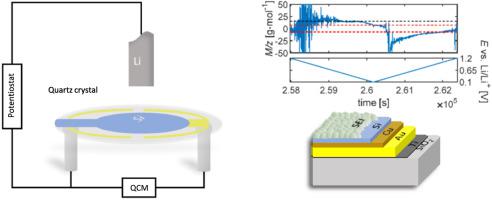Nano Energy ( IF 16.8 ) Pub Date : 2021-02-16 , DOI: 10.1016/j.nanoen.2021.105886 Tobias Kohler , Efi Hadjixenophontos , Yug Joshi , Ke Wang , Guido Schmitz

|
Silicon is a hot candidate for battery anodes as its theoretical storage capacity is almost ten times larger than that of graphite. Volume expansion and kinetic limitations require the nanostructuring in particles, wires or thin films. One feature that still puzzles researchers is the solid electrolyte interface (SEI). Here we use an electrochemical quartz crystal microbalance (QCM) to inspect in-situ SEI formation on Si films. The measured mass uptake is split into a reversible part representing the battery function and an irreversible part attributed to continuous SEI formation. The evaluation of the latter quantifies the dependence of SEI growth on cycling window, rate and anode thickness. More striking is the reversible part. Advanced QCM mass spectrometry enables identification of the ab/desorbed species. Surprisingly, half of the battery storage is not due to lithiation but due to reversible adsorption of Li2O to the SEI layer. The dependence on rate and film thickness indicates this Li2O is formed by a self-limited, field-driven layer growth.
中文翻译:

硅阳极循环过程中可逆的氧化物形成
硅是电池阳极的热门候选材料,因为其理论存储容量几乎是石墨的十倍。体积膨胀和动力学限制要求颗粒,金属丝或薄膜具有纳米结构。仍然困扰着研究人员的一个功能是固体电解质界面(SEI)。在这里,我们使用电化学石英晶体微量天平(QCM)来检查Si膜上的原位SEI形成。测得的质量吸收分为代表电池功能的可逆部分和归因于连续SEI形成的不可逆部分。后者的评估量化了SEI增长对循环窗口,速率和阳极厚度的依赖性。更加引人注目的是可逆部分。先进的QCM质谱仪能够鉴定抗体/解吸的物质。出奇,2 O到SEI层。对速率和膜厚的依赖性表明,该Li 2 O是由自限场驱动层生长形成的。











































 京公网安备 11010802027423号
京公网安备 11010802027423号